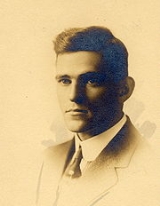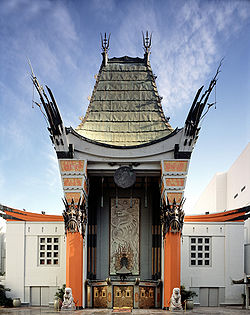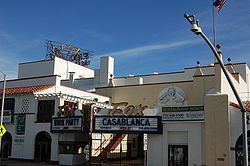
Raymond M. Kennedy
Encyclopedia
Raymond McCormick Kennedy was the guiding light and architect of the Grauman's Chinese Theater that opened in May 1927.
in 1891. He graduated from Cornell University
in 1915 at the top of his class with a Bachelor's degree in Architecture for which he received the American Institute of Architects
Medal for General Excellence in Architecture. At this time he was also awarded the John Plaut Fellowship which paid for his return to Cornell for post graduate work. In 1916 Kennedy earned his Master's in Architecture at Cornell. Upon his completion of this degree he was awarded the American "Grand Prix de Rome" Scholarship in Architecture. This coveted prize entitled the recipient to three years of resident study at the Academy in Rome
and included a stipend to cover expenses. His studies in Italy were interrupted by World War I
. He volunteered to serve for the American Red Cross
of Italy. This service delayed his studies in Rome for a year. While in Rome he completed several classically styled projects and in 1920 he was awarded the Diploma as a Fellow of the American Academy in Rome
.
Kennedy returned from his studies in Italy in 1920. He obtained his first employment with the firm of York and Sawyer
in New York City
. However, the prevailing architectural design philosophy of this firm gave Kennedy no opportunity to express his creative and artistic talents. Subsequently Kennedy had a more rewarding design opportunity with the Greenley firm in New York.
in Los Angeles, California
. In this position he began an expanded activity in his career. While associated with Meyer & Holler, Kennedy was able to leave his mark on the architectural landscape of early modern Los Angeles. In 1929 the firm of Meyer & Holler was greatly impacted by the Great Depression. The decline in real estate values and dramatically lowered demand for construction in general brought to an end the operations of Meyer & Holler.


for Sid Grauman
. The ground breaking for the Chinese took place on January 5, 1926, and the construction was to be completed by December 28, 1926. The grand opening of Grauman's Chinese Theater in Hollywood, California
was on May 18, 1927 and was the most spectacular theater opening in motion picture history.
Kennedy's design of the theater displayed his classical, sophisticated training and his exuberant use of color and unique styles. Kennedy, along with fellow architect Donald Wilkinson, arranged the forecourt and facade of the Chinese theater to echo the layout of the Piazza San Pietro and the massing of Sant'Andrea al Quirinale
in Rome
, respectively. He thus managed to subtly associate the function of the movie theater with that of sacred space, thereby helping to legitimize the cinema at a time when its morality was being questioned.
. His major position was professor of architectural design but he also conducted classes in mural painting, free hand sketching, and architectural modeling. His architectural students flourished under his tutelage and subsequently won many design awards. He became one of their favorite professors and was invited to many student reunions as a featured speaker. Teaching assignments for Kennedy were scheduled in the afternoons which left the mornings free for other employment. In the mornings he would design sets for the movie studios of Metro Goldwyn Mayer and Republic Studios.
in Washington D.C.
At the completion of his employment at the University of Southern California in 1942, Kennedy again became active in strictly architectural work. This activity was divided between the offices of Robert E. Bennett of Pasadena and William H. Harrison of Los Angeles. In association with these two firms, Kennedy worked on many other projects including libraries, schools, a city hall, and a chapel.
Kennedy retired at the age of 69 in 1960. During his retirement years Kennedy enthusiastically pursued his many hobbies of model railroads, woodworking, travel, photography, painting and writing. He was an avid reader with a romantic appreciation of poetry and music.
At the age of 85, on May 11, 1976, Kennedy died leaving his wife Myrtle, two sons, Raymond Kennedy Jr., Thomas Kennedy, and a multitude of aesthetically pleasing and functional buildings in Southern California.
Early life
Raymond McCormick Kennedy was born in New Brighton, PennsylvaniaNew Brighton, Pennsylvania
New Brighton is a borough in Beaver County, Pennsylvania, United States, located along the Beaver River northwest of Pittsburgh. There are deposits of coal and clay in the vicinity. In the past, articles produced here included pottery, bricks, sewer pipe, glass, flour, twine, lead kegs,...
in 1891. He graduated from Cornell University
Cornell University
Cornell University is an Ivy League university located in Ithaca, New York, United States. It is a private land-grant university, receiving annual funding from the State of New York for certain educational missions...
in 1915 at the top of his class with a Bachelor's degree in Architecture for which he received the American Institute of Architects
American Institute of Architects
The American Institute of Architects is a professional organization for architects in the United States. Headquartered in Washington, D.C., the AIA offers education, government advocacy, community redevelopment, and public outreach to support the architecture profession and improve its public image...
Medal for General Excellence in Architecture. At this time he was also awarded the John Plaut Fellowship which paid for his return to Cornell for post graduate work. In 1916 Kennedy earned his Master's in Architecture at Cornell. Upon his completion of this degree he was awarded the American "Grand Prix de Rome" Scholarship in Architecture. This coveted prize entitled the recipient to three years of resident study at the Academy in Rome
Rome
Rome is the capital of Italy and the country's largest and most populated city and comune, with over 2.7 million residents in . The city is located in the central-western portion of the Italian Peninsula, on the Tiber River within the Lazio region of Italy.Rome's history spans two and a half...
and included a stipend to cover expenses. His studies in Italy were interrupted by World War I
World War I
World War I , which was predominantly called the World War or the Great War from its occurrence until 1939, and the First World War or World War I thereafter, was a major war centred in Europe that began on 28 July 1914 and lasted until 11 November 1918...
. He volunteered to serve for the American Red Cross
American Red Cross
The American Red Cross , also known as the American National Red Cross, is a volunteer-led, humanitarian organization that provides emergency assistance, disaster relief and education inside the United States. It is the designated U.S...
of Italy. This service delayed his studies in Rome for a year. While in Rome he completed several classically styled projects and in 1920 he was awarded the Diploma as a Fellow of the American Academy in Rome
American Academy in Rome
The American Academy in Rome is a research and arts institution located on the Gianicolo in Rome.- History :In 1893, a group of American architects, painters and sculptors met regularly while planning the fine arts section of the 1893 World's Columbian Exposition...
.
Kennedy returned from his studies in Italy in 1920. He obtained his first employment with the firm of York and Sawyer
York and Sawyer
The architectural firm of York and Sawyer produced many outstanding structures, exemplary of Beaux-Arts architecture as it was practiced in the United States. The partners Edward York and Philip Sawyer had both trained in the office of McKim, Mead, and White...
in New York City
New York City
New York is the most populous city in the United States and the center of the New York Metropolitan Area, one of the most populous metropolitan areas in the world. New York exerts a significant impact upon global commerce, finance, media, art, fashion, research, technology, education, and...
. However, the prevailing architectural design philosophy of this firm gave Kennedy no opportunity to express his creative and artistic talents. Subsequently Kennedy had a more rewarding design opportunity with the Greenley firm in New York.
Meyer & Holler
His employment was to be short lived however since in 1920 Kennedy accepted the position of architectural designer within the "design and build" firm of Meyer & HollerMeyer & Holler
Meyer & Holler was an architecture firm based in Los Angeles, California noted for its opulent commercial buildings and movie theatres, including Grauman’s Chinese and Egyptian theatres, built during the 1920s...
in Los Angeles, California
Los Angeles, California
Los Angeles , with a population at the 2010 United States Census of 3,792,621, is the most populous city in California, USA and the second most populous in the United States, after New York City. It has an area of , and is located in Southern California...
. In this position he began an expanded activity in his career. While associated with Meyer & Holler, Kennedy was able to leave his mark on the architectural landscape of early modern Los Angeles. In 1929 the firm of Meyer & Holler was greatly impacted by the Great Depression. The decline in real estate values and dramatically lowered demand for construction in general brought to an end the operations of Meyer & Holler.


Selected buildings
- First Church Christian Scientists, Los Angeles
- First Church Christian Scientists, Glendale
- Fox Theatre (Fullerton)Fox Theatre (Fullerton)Fox Theatre is a movie theater located on Harbor Boulevard in Fullerton, California. Built in 1925 as part of the chain of Fox Theatres, the theater was closed and abandoned in 1987. The Fullerton Historic Theatre Foundation is currently in the process of fundraising and restoring the...
, Fullerton - Grauman's Chinese Theater, Hollywood
- Hollywood National Building, Hollywood
- International Mart Building, Los Angeles
- Ocean Center BuildingOcean Center BuildingThe Ocean Center Building is a 14-story, 197-foot-tall office building in downtown Long Beach, California built in 1929 by architect Raymond M...
, Long Beach - Petroleum Securities Building, Los Angeles
- Quinby Office Building, Los Angeles
- Twenty Sixth Church of Christian Scientists, Los Angeles
Grauman's Chinese Theater
The Chinese Theater has taken a significant place in world architectural history and an iconic part of Hollywood. Kennedy was responsible for 99% of all sketches made of the architectural features for the theater that was developed by his employer, Meyer and Holler. Meyer and Holler was the design-build firm that had already built Grauman's Egyptian TheatreGrauman's Egyptian Theatre
Grauman's Egyptian Theatre on Hollywood Boulevard in Hollywood, California, is one of the world's most famous movie theatres. Opened in 1922, it was the venue for the first-ever Hollywood premiere.- History :...
for Sid Grauman
Sid Grauman
Sidney Patrick Grauman was an American showman who created one of Southern California's most recognizable and visited landmarks, Grauman's Chinese Theater. He was the son of David Grauman who died in 1921 in Los Angeles, California and Rosa Goldsmith...
. The ground breaking for the Chinese took place on January 5, 1926, and the construction was to be completed by December 28, 1926. The grand opening of Grauman's Chinese Theater in Hollywood, California
Hollywood, Los Angeles, California
Hollywood is a famous district in Los Angeles, California, United States situated west-northwest of downtown Los Angeles. Due to its fame and cultural identity as the historical center of movie studios and movie stars, the word Hollywood is often used as a metonym of American cinema...
was on May 18, 1927 and was the most spectacular theater opening in motion picture history.
Kennedy's design of the theater displayed his classical, sophisticated training and his exuberant use of color and unique styles. Kennedy, along with fellow architect Donald Wilkinson, arranged the forecourt and facade of the Chinese theater to echo the layout of the Piazza San Pietro and the massing of Sant'Andrea al Quirinale
Sant'Andrea al Quirinale
The Church of Saint Andrew's at the Quirinal is a Roman Catholic titular church in Rome, built for of the Jesuit seminary on the Quirinal Hill....
in Rome
Rome
Rome is the capital of Italy and the country's largest and most populated city and comune, with over 2.7 million residents in . The city is located in the central-western portion of the Italian Peninsula, on the Tiber River within the Lazio region of Italy.Rome's history spans two and a half...
, respectively. He thus managed to subtly associate the function of the movie theater with that of sacred space, thereby helping to legitimize the cinema at a time when its morality was being questioned.
University of Southern California
Kennedy left the defunct firm of Meyer & Holler and secured a teaching position at the University of Southern CaliforniaUniversity of Southern California
The University of Southern California is a private, not-for-profit, nonsectarian, research university located in Los Angeles, California, United States. USC was founded in 1880, making it California's oldest private research university...
. His major position was professor of architectural design but he also conducted classes in mural painting, free hand sketching, and architectural modeling. His architectural students flourished under his tutelage and subsequently won many design awards. He became one of their favorite professors and was invited to many student reunions as a featured speaker. Teaching assignments for Kennedy were scheduled in the afternoons which left the mornings free for other employment. In the mornings he would design sets for the movie studios of Metro Goldwyn Mayer and Republic Studios.
Post USC
His teaching work at U.S.C. was interrupted during September and October 1941 when he left to be a Consulting Architect on the design of the future PentagonThe Pentagon
The Pentagon is the headquarters of the United States Department of Defense, located in Arlington County, Virginia. As a symbol of the U.S. military, "the Pentagon" is often used metonymically to refer to the Department of Defense rather than the building itself.Designed by the American architect...
in Washington D.C.
At the completion of his employment at the University of Southern California in 1942, Kennedy again became active in strictly architectural work. This activity was divided between the offices of Robert E. Bennett of Pasadena and William H. Harrison of Los Angeles. In association with these two firms, Kennedy worked on many other projects including libraries, schools, a city hall, and a chapel.
Kennedy retired at the age of 69 in 1960. During his retirement years Kennedy enthusiastically pursued his many hobbies of model railroads, woodworking, travel, photography, painting and writing. He was an avid reader with a romantic appreciation of poetry and music.
At the age of 85, on May 11, 1976, Kennedy died leaving his wife Myrtle, two sons, Raymond Kennedy Jr., Thomas Kennedy, and a multitude of aesthetically pleasing and functional buildings in Southern California.

